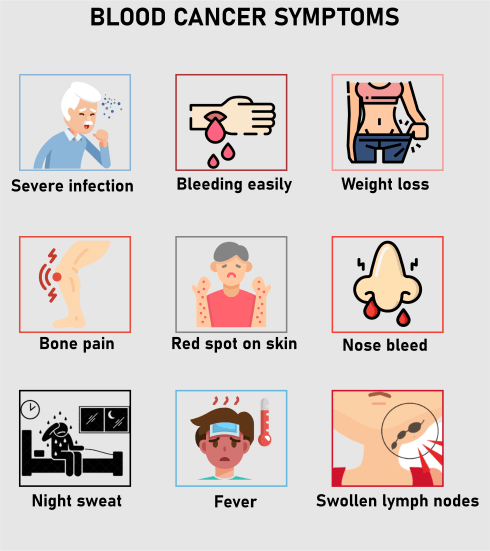Blood CancerBlood Cancer is generally defined as the abnormal growth of blood cells. In cancer overgrowth of an abnormal form of blood cell interferes with the normal development of blood cells in most blood cancers. Most hematopoietic tumours also known as blood cancers, start in the bone marrow, where blood is produced. Blood cancer develop when abnormal blood cells begin to proliferate out of control, obstructing the ability of the regular blood cells to fight off infection and produce new blood cells. These abnormal cells are also known as cancerous cells. Blood cancers affect how the blood cells grow and function. The bone marrow's stem cells can mature and develop into RBCs, WBCs or platelets. Different Types of Blood CancersBlood cancer is a combination of a variety of illnesses, each with separate categories. The five significant types of blood cancers are listed below:
1. Leukaemia Leukaemia is brought on by the rapid growth and destruction of healthy blood cells by abnormal white blood cells in the bone marrow. Infection risk increases as a result. Leukaemia is mainly found in persons over 55 and is the most prevalent type of blood cancer. 2. Lymphoma White blood cells comprise a large portion of the lymph fluid, where lymphomas and malignancies first develop. The body uses lymph to combat infections. A form of blood cancer is lymphoma when the lymphatic system is overloaded by abnormal white blood cells. The body's lymphatic system comprises the following:
3. Myelodysplastic Syndrome These cancers develop when some bone marrow-derived blood stem cells are not able to develop into normal cells. The immature cells, also known as blasts, take up space in the bone marrow or the blood and do not function effectively. People at the age of 60 are mostly affected by this type of cancer. 4. Myeloproliferative Syndrome In this type of blood, syndrome malignancies are brought on by abnormalities in the bone marrow, the tissue that produces blood cells. A huge number of blood cells are produced by the body due to these alterations. The diagnosis depends on the type of blood cell and helps determine the type of blood cancer. 5. Myeloma multiforme The tumour of the plasma cells, which create antibodies to fight sickness and infection, is known as myeloma. It is often known as Myeloma multiforme, Kahler syndrome, Myelomatosis and Particulate cell myeloma. Blood Cancer Signs and Symptoms
There are various blood cancers, but the symptoms are similar and have dangerous indications. Based on the symptoms, they can also think they have a terrible cold or the flu. Some common signs and symptoms of blood cancer include:
Diagnosis of the Blood CancerThe treatment team will conduct tests to determine the kind and phase of the blood cancer. Screening and diagnosis take place simultaneously. Several examinations are used to detect blood cancer. The following tests and techniques are used to identify blood cancers:
Cancer TreatmentThe various types of common blood cancers can be treated in the following ways: Transplant of stem cells: Transplantation of stem cells results in the body receiving healthy plasma stem cells. Bone marrow and blood that is flowing and sometimes the umbilical cord can be used to harvest stem cells. Chemotherapy: Chemotherapy employs anti-cancer medications to prevent and stop the development of cancer cells within the body. Radiation treatment: Radiation treatment may be used to destroy cancer cells.
Next TopicComposition of Blood
|
 For Videos Join Our Youtube Channel: Join Now
For Videos Join Our Youtube Channel: Join Now
Feedback
- Send your Feedback to [email protected]
Help Others, Please Share










